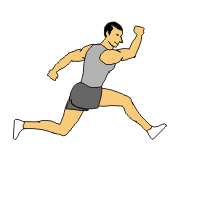AmeliaBurton.com
What’s your training program like? Do you focus on increasing your miles each week, maybe a bit of speed work here and there, and of course a token stretch at the end of each session? Well hats off to you because unlike 85% of the population at least you are doing something! But whether you are an amateur runner or a competitive athlete, adding a resistance session each week might just be the thing you need to take your further, faster and with fewer injuries. This article looks at the reasoning behind resistance training for runners and identifies the top resistance training exercises all runners should do.What is Resistance training for distance running?
Conventionally we think of resistance training as weights machines, dumbbells, slow movements and heavy weights (with lots of grunting). Resistance training for runners is quite different. It’s about loading the muscles in a manner that replicates running to improve their strength power, endurance and most importantly coordination. It’s about identifying the weaker muscles in the body and developing them to prevent injury. It is NOT about building unnecessary bulk or damaging already fatigued tissue and I must stress that incorrect resistance training can tighten you up and slow you down.
What purpose does it serve?
There are four key areas that resistance training will help you with: Speed, muscular endurance, efficiency of running technique, and injury prevention.
- Increase strength of your prime movers for speed and distance: The stronger your quads, glutes and hamstrings are the faster your will go and the longer you will be able to maintain your pace. Obviously nothing beats running to strengthen these, but resistance work involving sprints, uphill and downhill running improve their strength much faster.
- Prevents injury by Increase strength of your stabilisers: Your prime movers can only work as hard as your stabilisers will allow. It doesn’t matter how strong/fit you are, if you have poor hip knee and ankle stability, you will never reach your full potential in both speed and endurance.
- Increase coordination: Similar to stability, the faster you fatigue the sooner your coordination goes. Look at a distance athlete and how smooth their running style is. That is good coordination. All muscles, tendons, ligaments and joint actions are working in smooth unison to create effortless strides. The more fatigued you get the worse these actions interrelate creating a less economical stride which slows you down and increases your chance of injury.
- Increase stride length: As you fatigue, your stride naturally shortens, your muscles tighten and you slow down. By increasing your stride length (within reason) you can maintain a faster pace and waste less energy through excessive foot strikes.
Two Training Programs for Runners
Click here for a printable program you can take to the park/oval for your resistance session. Ideally you will need a stop watch and a skipping rope, but exercises can be performed without them.
Click here for a printable program for Core Stability and VMO/Glute Activation. You will need a swiss ball and leg extension machine for these.
The below animations will help you understand the exercises in the programs. Familiarize yourself with these exercises before printing out your workout sheets:
Skipping/Hopping

Bounding

Jumping on/off step

Plyometric Lunges

Burpees

1. Start in a standing position and bend your knees and place your hands on the ground.
2. Extend your legs back into a push up position. Bring your knees back in towards chest and explosively jump in the air.
3. This should be a continuous motion and be fluid.
2. Extend your legs back into a push up position. Bring your knees back in towards chest and explosively jump in the air.
3. This should be a continuous motion and be fluid.
Walking Lunges (Hand weights optional)

Single Leg Squat (Try not to hold on and I prefer foot to balance in air not across other leg)

What are the best muscle balancing exercises for injury prone runners?

Leg Extension: from 15-30degrees, toes turned out slightly, focusing on VMO activation. Light weight. 3 x 15-20 reps.


Lunges: Focus on the VMO of the front leg and glutes of the front leg. Keep your knees tracking straight and don’t let them internally rotate as you lower.

Core Stability exercises: Click here for a printable program
1. Alternating Single Leg Bridge
3 x 15 reps
3 x 15 reps
2.Double Leg Pike:
2 x 2 min
3. Alternate Arm Swings and Single Leg Raises

4. Side Raises on Ball
3 x 12 each side

For more detailed core stability exercises, click on my core stability four part series linked here.
- Core Stability Part 1- A Remedy For Back Pain
- Core Stability Part 2: The spinal neutral test
- Core Stability Part 3: Challenging your core muscles
- Core Stability Part 4: Functional Exercises -the plank and its wacky variations
- Abdominal Exercises: Exercise Your Oblique Muscles to Get Rid of the Love Handles




No comments:
Post a Comment